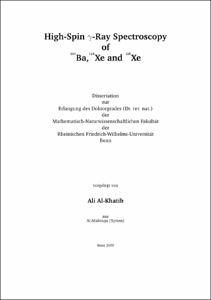High-Spin γ-Ray Spectroscopy of 124Ba, 124Xe and 125Xe

High-Spin γ-Ray Spectroscopy of 124Ba, 124Xe and 125Xe

| dc.contributor.advisor | Hübel, Herbert | |
| dc.contributor.author | Al-Khatib, Ali | |
| dc.date.accessioned | 2020-04-14T02:23:34Z | |
| dc.date.available | 2020-04-14T02:23:34Z | |
| dc.date.issued | 27.08.2009 | |
| dc.identifier.uri | https://hdl.handle.net/20.500.11811/4121 | |
| dc.description.abstract | Rotational spectra had been observed for the first time in excited atomic nuclei in 1938. This observation was attributed to the deviation from spherical shape. In quantum mechanics, when a perfectly spherical system rotates, it appears identical when it is viewed from any direction and no point of reference exists to which the change in position can be identified. Therefore, rotation cannot be defined for spherical nuclei. If the shape deviates from spherical symmetry, the nucleus can rotate and rotational spectra are observed. Many nucleons contribute to the rotation which is referred to as collective excitation. Depending on the mass region, nuclei have different deformations and, therefore, different shapes. Many nuclei show larger deformation with increasing excitation energy. Transitional nuclei between spherical and strongly deformed regions of the nuclear chart are usually soft with respect to deformation changes. In the mass region around A ~125, which is the subject of this thesis, nuclei are predicted to be soft with respect to deformation. Rotational motion leads to Coriolis-induced alignments of high-j nucleons, which are in this mass region predominantly protons and neutrons from the h11/2 unique-parity intruder subshells. The proton Fermi level lies in the lower part of the h11/2 subshell which favours prolate shape whereas the neutron Fermi level lies in the upper part of the h11/2 subshell which favours oblate shape. According to the opposite shape-driving forces of protons and neutrons, shape co-existence is expected and the interplay between the h11/2 proton and neutron orbitals is of great interest for spectroscopic investigations. In addition, superdeformation has been established in this mass region. An interesting observation in this mass region is that nuclei undergo a shape-change from collective prolate to non-collective oblate states at high spins. In this spin range the transitions within the rotational bands loose collectivity and, finally, when all nucleons outside the core have their spins aligned, the bands terminate. In the framework of this thesis, extensive spectroscopic investigations of three nuclei of the A ~125 region, 124Ba, 124Xe and 125Xe, have been performed. These nuclei have been studied with the largest spectrometers available, Euroball and Gammasphere. The previously known level schemes of these nuclei have been extended substantially, both in the low- and high-spin regions. Many new rotational bands could be established. Lifetimes have been measured for several of the long large-deformation bands. The rotational structures, shape co-existence and band termination at high spins have been investigated. | en |
| dc.language.iso | eng | |
| dc.rights | In Copyright | |
| dc.rights.uri | http://rightsstatements.org/vocab/InC/1.0/ | |
| dc.subject.ddc | 530 Physik | |
| dc.title | High-Spin γ-Ray Spectroscopy of 124Ba, 124Xe and 125Xe | |
| dc.type | Dissertation oder Habilitation | |
| dc.publisher.name | Universitäts- und Landesbibliothek Bonn | |
| dc.publisher.location | Bonn | |
| dc.rights.accessRights | openAccess | |
| dc.identifier.urn | https://nbn-resolving.org/urn:nbn:de:hbz:5N-18552 | |
| ulbbn.pubtype | Erstveröffentlichung | |
| ulbbnediss.affiliation.name | Rheinische Friedrich-Wilhelms-Universität Bonn | |
| ulbbnediss.affiliation.location | Bonn | |
| ulbbnediss.thesis.level | Dissertation | |
| ulbbnediss.dissID | 1855 | |
| ulbbnediss.date.accepted | 18.08.2009 | |
| ulbbnediss.fakultaet | Mathematisch-Naturwissenschaftliche Fakultät | |
| dc.contributor.coReferee | Brinkmann, Kai-Thomas |
Dateien zu dieser Ressource
Das Dokument erscheint in:
-
E-Dissertationen (4398)




